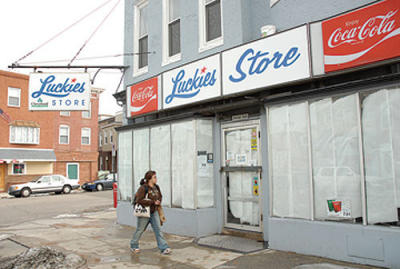Is it "gentrification" if your store can't change?

Christopher Myers, Baltimore Business Journal. This Luckies store is one of five owned by former Lucky’s employees.
If you listen and think at the same time, commercial district revitalization is a great learning process. I have complained before that people say "Your business isn't meeting my needs," and business proprietors respond accusing people of saying "we don't want African-American businesses." (See Commerz in the 'hood... (aka "Commerce as the engine of urbanism") from last April.)
The real issues are expectations and quality.
Two fascinating conversations I've had are:
1. Listening to the proprietor of a candy store on Girard Avenue in Philadelphia rail against supermarkets for changing the laws about manufacturing ice cream and the amount of air allowed, and how this wrecked his business for selling ice cream. I merely replied that he was selling "experience" and should have priced his ice cream accordingly. He didn't want to hear it.
See "Young's Candy Shop (Working with independent merchants is difficult)."
2. Listening to a vendor in Cross Street Market, a public market in Federal Hill in Baltimore, complain about the new demographics of the neighborhood. Cross Street Market is struggling, meanwhile the neighborhood has improved its demographics significantly. The businesses in the Market haven't been able to get their heads around the new customers. So new residents of Federal Hill merely go to Whole Foods Market.
This is relevant in relationship to this story from the Baltimore Business Journal, "Grocery's luck runs out in Federal Hill." Just looking at the photo, no wonder the store closed. It didn't meet the demands of the new clientele.
Staying the same when your prospect base changes dooms your business to failure.
Labels: retail, urban revitalization



0 Comments:
Post a Comment
<< Home